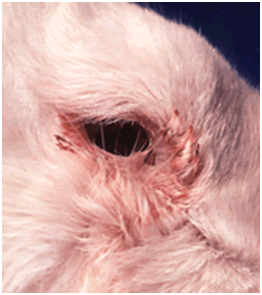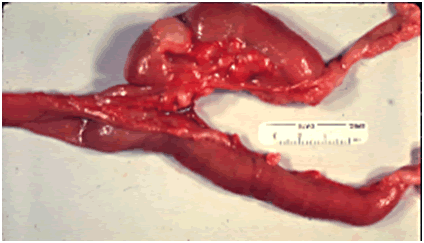Etiology: Pasteurella multocida is a small, Gram-negative, short bacillus/cocobacillus. It is non-motile and non-spore forming.
Incidence: Incidence of infection and disease is common in research animals.
Transmission: Transmission occurs by direct contact and less commonly, aerosol. Many rabbits are asymptomatic carriers.
Clinical Signs: There are several manifestations of the disease. Upper respiratory disease (“snuffles”), pneumonia, otitis media, pyometra, orchitis, subcutaneous abscesses, conjunctivitis, and septicemia are manifestations of P. multocida infection. Onset of clinical disease is often associated with underlying stressors.
Snuffles: This is the most common clinical manifestation of pasteurellosis. Signs include serous to mucopurulent nasal exudate with sneezing and nasal stridor. Exudate may be seen on the nose and forepaws. Nasal mucosal erosions with edema, hyperemia and neutrophilic exudate may be visible. Snuffles may progress to lower respiratory disease, conjunctivitis, or otitis media.
Conjunctivitis: This is the second most common manifestation of infection. Signs include mucoid/mucopurulent discharge and conjunctival hyperemia, with development of chronic epiphora and inflammation, and eventual stenosis of the nasolacrimal duct.

Otitis media and interna: Torticollis may be seen in ~15% of rabbits with otitis media and occurs when inflammation extends to the vestibular apparatus. Bullae are filled with serosanguinous to purulent material.

Pneumonia: Pneumonia occurs in approximately 20% of rabbits with upper respiratory disease. Rarely there is evidence of upper respiratory disease, so affected rabbits may die acutely with no signs; anorexia and depression may be observed. Acute pneumonia lesions include red-grey foci of consolidation of the cranioventral lung lobes with or without hemorrhage. Fibrinopurulent necrotizing bronchopneumonia occurs, often with abscess formation. Fibrinopurulent pleuritis, pericarditis and pyothorax are frequent sequelae.

Abscesses: Contaminated wounds and septicemia are common routes for abscess development in a variety of locations but most commonly in the subcutis of the head and shoulders. The presence of subcutaneous swellings which are filled with creamy exudate and may have draining fistulous tracts is typical of Pasteurella abscesses.
Genital Infections: Infection occurs by venereal transmission. Metritis, orchitis, and epididymitis often develop into abscesses. Female rabbits may have a vaginal discharge which may be serous to mucopurulent and/or a history of infertility.

Septicemia: Septicemic rabbits usually die acutely without clinical signs. Bacteremia may be secondary to pneumonia or rhinitis, and serosal and endocardial hemorrhages may be appreciated.
Diagnosis: Culture of multiple sites including nasal cavity, paranasal sinuses, nasopharynx and tympanic bullae can be used. ELISA can be used but should be repeated multiple times over the course of several weeks. PCR can be used to detect infection with Pasteurella.